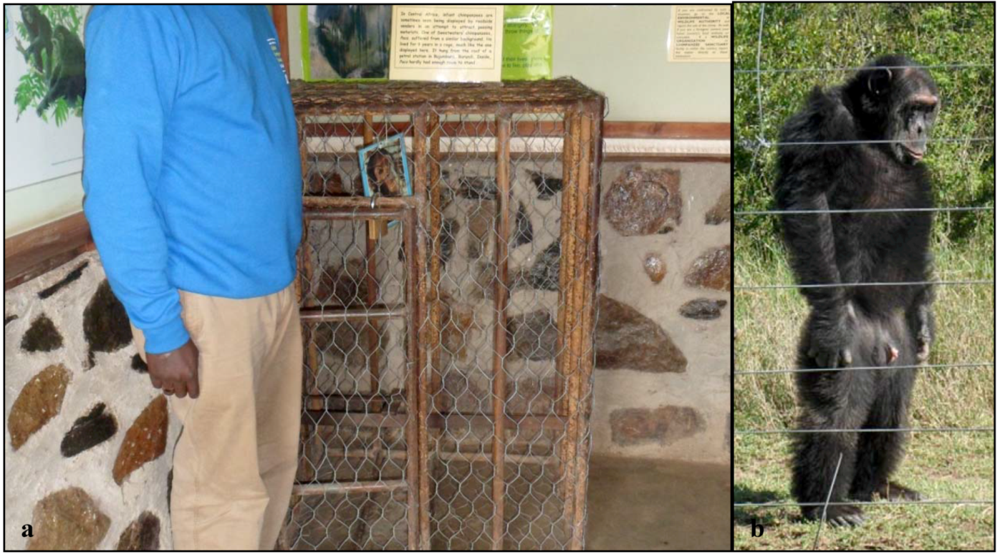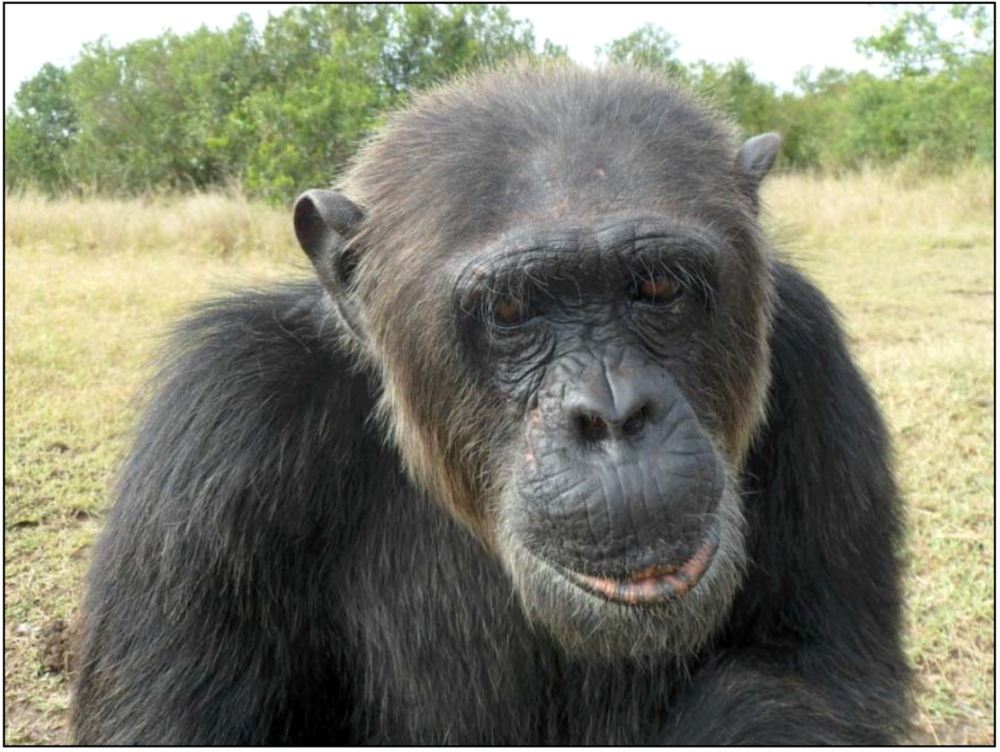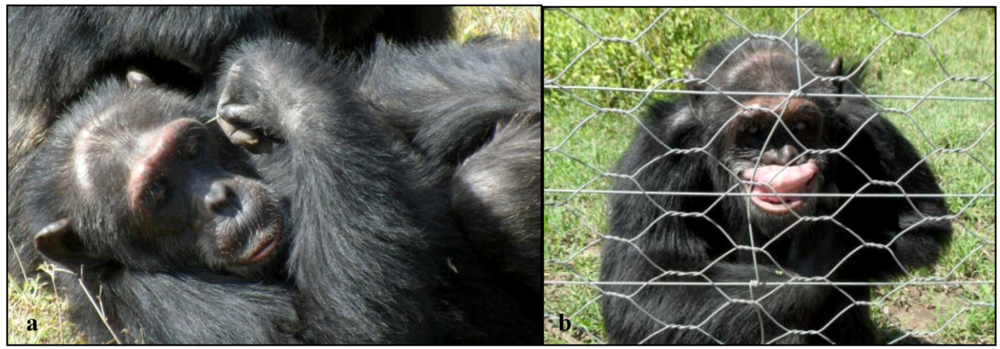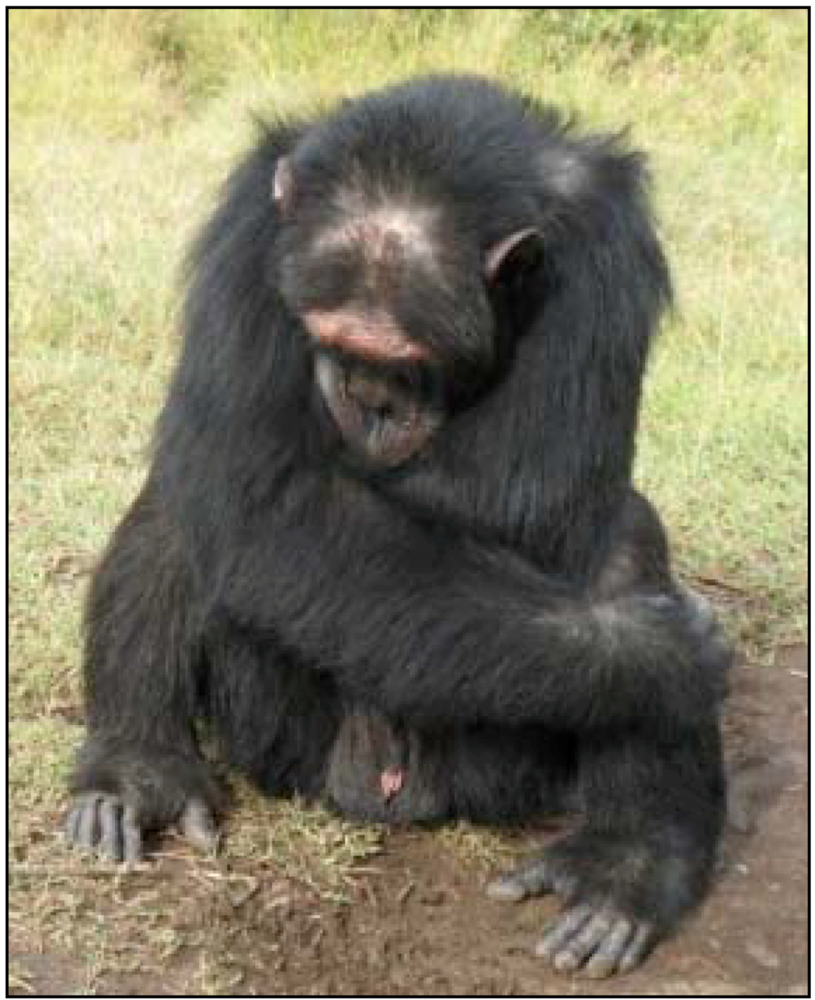Stereotypical Behaviors in Chimpanzees Rescued from the African Bushmeat and Pet Trade
Abstract
:1. Introduction
2. Experimental Section
2.1. Research Site
| Age Category | |||
|---|---|---|---|
| Sex | Infants and Juveniles | Adolescents and Young Adults | Prime, Mature, and Old Adults |
| 1–7 years | 8–15 years | 16 years + | |
| Males | - | 5 | 4 |
| Females | 2 | 3 | 7 |
2.2. Caregiver Interviews
2.3. Chimpanzee Background Information from Interviews
2.3.1. Poco Background Information
2.3.2. Safari Background Information



2.4. Chimpanzee Observations
3. Results and Discussion
3.1. Poco Naturalistic Observation Results

| Behavioral Context | ||||
|---|---|---|---|---|
| Behavior | Human Oriented (19%) | Solitary (59%) | Affiliating (14%) | Interacting (8%) |
| Normal 418 (66%) | 80 (65) | 295 (79) | 30 (35) | 13 (25) |
| Abnormal 219 (34%) | 43 (35) | 80 (21) | 56 (65) | 40 (75) |
| Total N = 637* | 123 | 375 | 86 | 53 |

3.2. Safari Naturalistic Observation Results

| Behavioral Context | ||||
|---|---|---|---|---|
| Behavior | Human Oriented (9.5%) | Solitary (46%) | Affiliating (28%) | Interacting (16.5%) |
| Normal 280 (43%) | 23 (37) | 163 (55) | 56 (31) | 38 (36) |
| Abnormal 368 (57%) | 39 (63) | 134 (45) | 126 (69) | 69 (64) |
| Total N = 648 * | 62 | 297 | 182 | 77 |
3.3. Discussion
4. Conclusions
Acknowledgments
Conflict of Interest
References
- Farmer, K.H. Pan-African Sanctuary Alliance: Status and range of activities for great ape conservation. Am. J. Primatol. 2002, 58, 117–132. [Google Scholar] [CrossRef]
- Ghobrial, L.; Lankester, F.; Kiyang, J.A.; Akih, A.E.; de Vries, S.; Fotso, R.; Gadsby, E.L.; Jenkins, P.D.; Gonder, M.K. Tracing the origins of rescued chimpanzees reveals widespread chimpanzee hunting in Cameroon. BMC Ecol. 2010, 10, 1–15. [Google Scholar] [CrossRef]
- Hicks, T.C.; Darby, L.; Hart, J.; Swinkles, J.; January, N.; Menken, S. Trade in orphans and bushmeat threatens one of the Democratic Republic of the Congo's most important populations of eastern chimpanzees (pan troglodytes schweinfurthii). Afric. Prim. 2010, 7, 1–18. [Google Scholar]
- Wolfe, N.D.; Daszak, P.; Kilpatrick, A.M.; Burke, D.S. Bushmeat hunting, deforestation, and prediction of zoonotic disease emergence. Emerg. Infect. Dis. 2005, 11, 1822–1827. [Google Scholar] [CrossRef]
- Selva, M. Chimpanzee babies starved by rare animal smugglers. The Independent, 5 February 2005. [Google Scholar]
- Brune, M.; Brune-Cohrs, U.; McGrew, W.C.; Preuschoft, S. Psychopathology in great apes: Concepts, Treatment options and possible homologies to human psychiatric disorders. Neurosci. Biobehav. Rev. 2006, 30, 1246–1259. [Google Scholar] [CrossRef]
- Davenport, R.K.; Rogers, C.M. Differential rearing of the chimpanzee. Chimpanzee 1970, 3, 337–360. [Google Scholar]
- Goodall, J. The chimpanzees of Gombe: Patterns of behavior; Belknap Press of Harvard University Press: Cambridge, MA, USA, 1986. [Google Scholar]
- Birkett, L.; Newton-Fisher, N.E. How Abnormal is the behaviour of captive, zoo-living chimpanzees? PLoS ONE 2011, 6, e20101. [Google Scholar]
- Bowlby, J. Attachment and Loss: Volume II: Separation, Anxiety and Anger; Basic Books, Inc.: New York, NY, USA, 1973. [Google Scholar]
- Bourgeois, S.R.; Vazquez, M.; Brasky, K. Combination therapy reduces self-injurious behavior in a chimpanzee (pan troglodytes troglodytes): A case report. J. Appl. Anim. Welf. Sci. 2007, 10, 123–140. [Google Scholar] [CrossRef]
- Bradshaw, G.A.; Capaldo, T.; Lindner, L.; Grow, G. Building an inner sanctuary: Complex PTSD in chimpanzees. J. Trauma Dissoc. 2008, 9, 9–34. [Google Scholar] [CrossRef]
- Harlow, H.F.; Harlow, M.K. Social deprivation in monkeys. Sci. Amer. 1962, 207, 136–146. [Google Scholar] [CrossRef]
- Kalcher, E.; Franz, C.; Crailsheim, K.; Preuschoft, S. Differential onset of infantile deprivation produces distinctive long-term effects in adult ex-laboratory chimpanzees (Pan troglodytes). Dev. Psychobiol. 2008, 50, 777–788. [Google Scholar] [CrossRef]
- Latham, N.R.; Mason, G.J. Maternal deprivation and the development of stereotypic behaviour. Appl. Ani. Behav. Sci. 2008, 110, 84–108. [Google Scholar] [CrossRef]
- Martin, J.E. Early life experiences: Activity levels and abnormal behaviours in resocialised chimpanzees. Anim. Welf. 2002, 11, 419–436. [Google Scholar]
- Nash, L.T.; Fritz, J.; Alford, P.A.; Brent, L. Variables influencing the origins of diverse abnormal behaviors in a large sample of captive chimpanzees (pan troglodytes). Am. J. Primatol. 1999, 48, 15–29. [Google Scholar] [CrossRef]
- Walsh, S.; Bramblett, C.A.; Alford, P.L. A vocabulary of abnormal behaviors in restrictively reared chimpanzees. Am. J. Primatol. 1982, 3, 315–319. [Google Scholar] [CrossRef]
- Hook, M.A.; Lambeth, S.P.; Perlman, J.E.; Stavisky, R.; Bloomsmith, M.A.; Schapiro, S.J. Inter-group variation in abnormal behavior in chimpanzees (Pan troglodytes) and rhesus macaques (Macaca mulatta). Appl. Anim. Behav. Sci. 2002, 76, 165–176. [Google Scholar] [CrossRef]
- Wobber, V.; Hare, B. Psychological health of orphan bonobos and chimpanzees in African sanctuaries. PLoS ONE 2011, 6, e1714. [Google Scholar]
- Davenport, R.K.; Menzel, E.W. Stereotyped Behavior of the Infant Chimpanzee. Arch. Gen. Psychiatr. 1963, 8, 99–104. [Google Scholar] [CrossRef]
- Dorey, N.R.; Rosales-Ruiz, J.; Smith, R.; Lovelace, B. Functional analysis and treatment of self-injury in a captive olive baboon. J. Appl. Behav. Anal. 2009, 42, 785–794. [Google Scholar] [CrossRef]
- Fabrega, H. Making sense of behavioral irregularities of great apes. Neurosci. Biobehav. Rev. 2006, 30, 1260–1273. [Google Scholar] [CrossRef]
- Novak, M.A. Primate psychopathology: New insights on etiology and physiology. Am. J. Primatol. 2001, 54, 111. [Google Scholar]
- Reimers, M.; Schwarzenberger, F.; Preuschoft, S. Rehabilitation of research chimpanzees: Stress and coping after long-term isolation. Horm. Behav. 2007, 51, 428–435. [Google Scholar] [CrossRef]
- Dyer, K.F.W.; Dorahy, M.J.; Hamilton, G.; McElhill, B. Anger, aggression, and self-harm in PTSD and complex PTSD. J. Clin. Psychol. 2009, 65, 1099–1114. [Google Scholar] [CrossRef]
- Fritz, J. Resocialization of asocial chimpanzees. In Primates, the Road to Self-sustaining Populations; Benirschke, K., Ed.; Springer-Verlag: New York, NY, USA, 1986; pp. 351–359. [Google Scholar]
- Mallapur, A.; Choudhury, B.C. Behavioral abnormalities in captive nonhuman primates. J. Appl. Anim. Welf. Sci. 2003, 6, 275–284. [Google Scholar]
- Rogers, C.M.; Davenport, R.K. Effects of restricted rearing on sexual behaviour of chimpanzees. Dev. Psychol. 1969, 1, 200–204. [Google Scholar] [CrossRef]
- American Psychiatric Association. Diagnostic and statistical manual of mental disorders, 4th ed.; American Psychiatric Association: Washington, DC, USA, 2000. [Google Scholar]
- Ferdowsian, H.R.; Durham, D.L.; Kimwele, C.; Kranendonk, G.; Otali, E.; Akugizibwe, T.; Mulcahy, J.B.; Ajarova, L.; Johnson, C.M. Signs of mood and anxiety disorders in chimpanzees. PLoS ONE 2011, 6, e19855. [Google Scholar]
- Ferdowsian, H.R.; Durham, D.L.; Johnson, C.M.; Brüne, M.; Kimwele, C.; Kranendonk, G.; Otali, E.; Akugizibwe, T.; Mulcahy, J.B.; Ajarova, L. Signs of generalized anxiety and compulsive disorders in chimpanzees. J. Vet. Behav. 2012, 7, 353–361. [Google Scholar]
- McMillan, F.D. Mental Health and Well-being in Animals; Blackwell Publishing: Oxford, UK, 2005. [Google Scholar]
- Herman, J.L. Complex PTSD: A syndrome in survivors of prolonged and repeated trauma. J. Trauma Stress. 1992, 5, 377–391. [Google Scholar] [CrossRef]
- Cantor, C.; Price, J. Traumatic entrapment, Appeasement and complex post-traumatic stress disorder: Evolutionary perspectives of hostage reactions, Domestic abuse and the Stockholm syndrome. Aust. N.Z.J. Psychiatry 2007, 41, 377–384. [Google Scholar] [CrossRef]
- van der Kolk, B.A.; McFarlane, A.C.; Weisaeth, L. Traumatic Stress: The Effects of Overwhelming Experience on Mind, Body, and Society; Guildford Press: New York, NY, USA, 1996; pp. 182–213. [Google Scholar]
- Luxenberg, T.; Spinazzola, J.; van der Kolk, B. Complex trauma and disorders of extreme stress (DESNOS). Diagnosis, part one: Assessment. Dir. Psychiat. 2001, 21, 373–415. [Google Scholar]
- Scheeringa, M.S.; Zeanah, C.H.; Drell, M.J.; Larrieu, J.A. Two approaches to the diagnosis of posttraumatic stress disorder in infancy and early childhood. J. Am. Acad. of Child Adolesc. Psychiatr. 1995, 34, 191–200. [Google Scholar] [CrossRef]
- Digman, J.M. Personality structure: Emergence of the five-factor model. Annu. Rev. Psychol. 1990, 41, 417–436. [Google Scholar] [CrossRef]
- King, J.E.; Figueredo, A.J. The Five-Factor Model plus dominance in chimpanzee personality. J. Res. Pers. 1997, 31, 257–271. [Google Scholar] [CrossRef]
- Weiss, A.; Inoue-Murayama, M.; Hong, K.-W.; Inoue, E.; Udono, S.; Ochiai, T.; Matsuzawa, T.; Hirata, S.; King, J.E. Assessing chimpanzee personality and subjective well-being in Japan. Am. J. Primatol. 2009, 71, 283–292. [Google Scholar] [CrossRef]
- Bradshaw, G.A.; Watkins, M. Trans-species psychology; Theory and praxis. Psyche. Nat. 2006, 75, 69–94. [Google Scholar]
- Rosati, A.G.; Herrmann, E.; Kaminski, J.; Krupenye, C.; Melis, A.P.; Schroepfer, K.; Tan, J.; Warneken, F.; Wobber, V.; Hare, B. Assessing the psychological health of captive and wild apes: A response to Ferdowsian et al. (2011). J. Comp. Psychol. 2012, 1–8. [Google Scholar] [CrossRef]
- Uher, J. Three methodological core issues of comparative personality research. Eur. J. Pers. 2008, 22, 475–496. [Google Scholar] [CrossRef]
- Uher, J.; Asendorpf, J.B. Personality assessment in the great apes: Comparing ecologically valid behavior measures, Behavior ratings, And adjective ratings. J. Res. Pers. 2008, 42, 821–838. [Google Scholar] [CrossRef]
- Wynne, C.D.L. The perils of anthropomorphism. Nature 2009, 428, 606. [Google Scholar] [CrossRef]
- Hann, C. Hugging the Chimps: Adventures in Burundi; AuthorHouse: Bloomington, IN, USA, 2004. [Google Scholar]
- Lutz, C.; Well, A.; Novak, M; Stereotypic and self-injurious behavior in rhesus macaques: A survey and retrospective analysis of environment and early experience. Am. J. Primatol. 2003, 60, 1–15. [Google Scholar]
- Lehner, P.N. Handbook of Ethological Methods, 2nd ed.; Addison Wesley Longman: Menlo Park, CA, USA, 1996. [Google Scholar]
- Paterson, J.D. Primate behavior: An exercise workbook, 2nd ed.; Waveland Press: Long Grove, IL, USA, 2001. [Google Scholar]
- The Jane Goodall Institute. The ChimpanZoo observers guide; The Jane Goodall Institute: Silver Spring, MD, USA, 1991. [Google Scholar]
- Nishida, T.; Zamma, K.; Matsusaka, T.; Inaba, A.; McGrew, W.C. Chimpanzee behavior in the wild: An audio-visual encyclopedia; Springer: Tokyo, Japan, 2010. [Google Scholar]
- Roth, S.; Newman, E.; Pelcovitz, D.; van der Kolk, B.; Mandel, F.S. Complex PTSD in victims exposed to sexual and physical abuse: Results from the DSM-IV field trial for Posttraumatic Stress Disorder. J. Trauma Stress. 1997, 10, 539–555. [Google Scholar]
- Back, S.E.; Killeen, T.; Foa, E.B.; Ana, E.J.S.; Gros, D.F.; Brady, K.T. Use of an integrated therapy with prolonged exposure to treat PTSD and comorbid alcohol dependence in an Iraq veteran. Am. J. Psychiat. 2012, 169, 688–691. [Google Scholar] [CrossRef]
- Bandelow, B.; Sher, L.; Bunevicius, R.; Hollander, E.; Kasper, S.; Zohar, J.; Möller, H.-J. Guidelines for the pharmacological treatment of anxiety disorders, Obsessive-compulsive disorder and posttraumatic stress disorder in primary care. Int. J. Psychiat. Clin. Prac. 2012, 16, 77–84. [Google Scholar] [CrossRef]
- Foa, E.B.; Hembree, E.A.; Rothbaum, B.O. Prolonged exposure therapy for PTSD: Emotional processing of traumatic experiences: Therapist guide; Oxford University Press: New York, NY, USA, 2007. [Google Scholar]
- Institute of Medicine. Treatment of Posttraumatic Stress Disorder: An Assessment of the Evidence; The National Academies Press: Washington, DC, USA, 2008. [Google Scholar]
- Sheerin, C.M.; Seim, R.W.; Spates, C.R. A new appraisal of combined treatments for PTSD in the era of psychotherapy adjunctive medications. J. Contemp. Psychother. 2012, 42, 69–76. [Google Scholar] [CrossRef]
- Herman, J.L. Trauma and Recovery: The Aftermath of Violence from Domestic Abuse to Political Terror; Basic Books: New York, NY, USA, 1997. [Google Scholar]
- Herman, J. Complex PTSD: A Syndrome in Survivors of Prolonged and Repeated Trauma. In Living with Terror, Working with Trauma; Knafo, D., Ed.; Bowman and Littlefield: Lanham, MD, USA, 2004. [Google Scholar]
- Hare, B. The science behind why chimpanzees are not Pets. Discover Magazine. 13 November 2009. Available online: http://blogs.discovermagazine.com/intersection/2009/11/13/chimpanzees-are-not-pets-2/ (accessed on 5 October 2012).
© 2013 by the authors; licensee MDPI, Basel, Switzerland. This article is an open access article distributed under the terms and conditions of the Creative Commons Attribution license (http://creativecommons.org/licenses/by/3.0/).
Share and Cite
Lopresti-Goodman, S.M.; Kameka, M.; Dube, A. Stereotypical Behaviors in Chimpanzees Rescued from the African Bushmeat and Pet Trade. Behav. Sci. 2013, 3, 1-20. https://doi.org/10.3390/bs3010001
Lopresti-Goodman SM, Kameka M, Dube A. Stereotypical Behaviors in Chimpanzees Rescued from the African Bushmeat and Pet Trade. Behavioral Sciences. 2013; 3(1):1-20. https://doi.org/10.3390/bs3010001
Chicago/Turabian StyleLopresti-Goodman, Stacy M., Marjanne Kameka, and Ashlynn Dube. 2013. "Stereotypical Behaviors in Chimpanzees Rescued from the African Bushmeat and Pet Trade" Behavioral Sciences 3, no. 1: 1-20. https://doi.org/10.3390/bs3010001
APA StyleLopresti-Goodman, S. M., Kameka, M., & Dube, A. (2013). Stereotypical Behaviors in Chimpanzees Rescued from the African Bushmeat and Pet Trade. Behavioral Sciences, 3(1), 1-20. https://doi.org/10.3390/bs3010001





